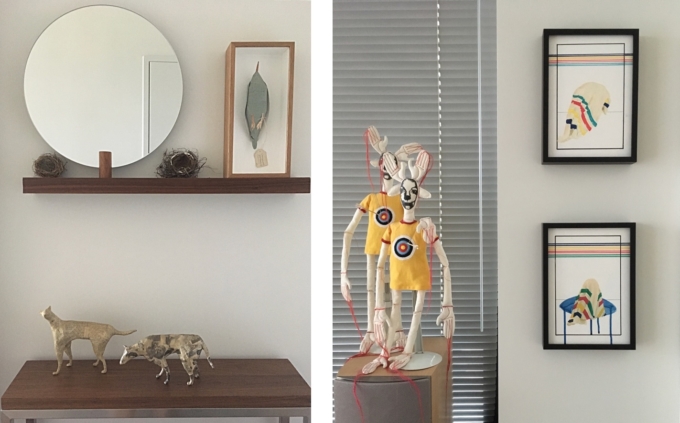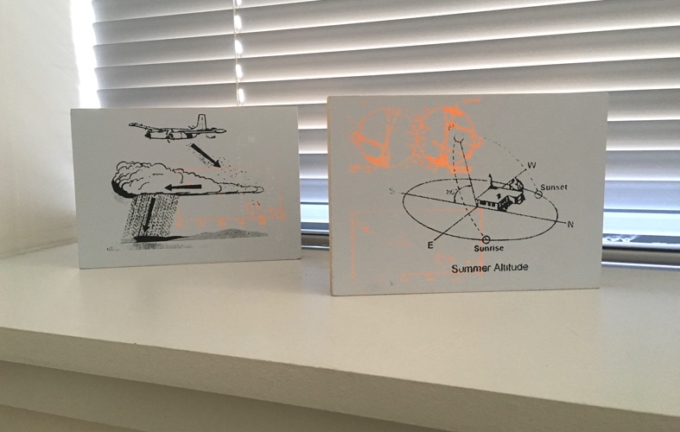How To Start Collecting Art
The only thing I adore more than making art is buying it. It’s such a joy to me to cohabitate with original work that inspires and delights.
While collecting works-on-paper is my jam – partly for size restrictions, partly for financial restrictions – my husband and I have a little bit of everything in our collection: drawings, mixed media and collage work, paintings, sculpture in various media, and ceramics (both decorative and utilitarian – I swear coffee tastes better out of a beautiful, artist-made mug).
My most recent acquisition was found at Trestle Art Space’s Small Works show. I felt an immediate, deep connection to Katelyn Patton’s mixed media canvas, Sad Girl on a Bed of Roses, and was so happy it was within my price limit.

L: Sad Girl on a Bed of Roses (full canvas); R: Sad Girl on a Bed of Roses (detail)
Making the decision to create a pleasing living environment while supporting artists was easy for me, but many folks are overwhelmed when it comes to buying art for the first time. Knowing how and where to start makes it less daunting.
Here are a few personal rules of thumb:
Decide ahead of time what your budget is. I set both yearly and per piece limits (i.e. $2,000 per year, $300-$1,000 per piece).
Give yourself some parameters. Do you like figurative work? Focus on that. Do you like ceramic sculpture? Focus on that. Works-on-paper? You can see where I’m going here 😉
Don’t buy as an investment. Buy what you like and what you want to live with (if it does turn out to be a good investment, it’s a bonus).
Buy from emerging artists. Price points are generally lower because artists are just beginning to develop their reputation (so you COULD be making an excellent investment). True story: years ago when I was living in Vancouver, BC (circa 1994) I saw some drawings that I fell in love with at a commercial gallery. At the time $400.00 seemed like a lot of money. Twenty-five years later that same artist (Marcel Dzama) is represented by David Zwirner and his original drawings start at 9,000 +. Sure wish I’d bought while I had the chance!
Look for art at artist-run or small-scale commercial galleries. When you buy from a smaller gallery you are helping these small venues stay open! This is important because fresh, new work often debuts at these locations first. Tip: group shows are a great way to see a variety of artist’s work in one place.
Visit artist’s open studios. Many artists will have their work for sale during an open studio event. The benefit of this scenario is that you will get to view several works by the same maker. You’ll develop a deeper understanding of their work and process, which will help you decide if that particular artist’s work resonates for you.
Consider how you’d feel living with the work. Sometimes I’ll know within a few minutes. Sometimes it takes months. Caveat: if you really connect with a piece, don’t wait too long. I returned to an art fair wanting to make a purchase and was heartbroken to find that the piece had sold in the two days since I’d first seen it.
Can’t afford much and/or don’t have a large display space? That’s absolutely OK. Start small. I have seen lots (and bought lots!) of amazing work priced from $80-400 at “small works” themed shows.
Not knowing how or where you might display original art in your home may also prevent you from starting a collection. Personally, I like to have art in every room of my home. Yes, even in the bathrooms. Here are a few ideas to get you thinking outside the display box.
Sculptural art, whether decorative or functional, looks lovely on side tables, consoles, or as a feature focus on a coffee table. Narrow walls invite an opportunity to group smaller works vertically.

Left (upper shelf) Coracias garrulus from the series A Forgotten Story by Sheridan Jones, (console) Dogs by Jim Seffens. Right (on speaker) Tourist Attraction figures by yours truly, (on wall from top) Blanketscape 11-003, Blanketscape 15-004 by Peter Gynd.
If you’re short on wall space, smaller works in deep frames stand up nicely on bookcases and window ledges.

Untitled by Paula Garrido Miranda & Ignacio Perez Kenchington.

Goddess by Eleanor Hannan, nestled in between my art books. Her shapes and color palette share a dialogue with the Jack Shadbolt book on the right.
Picture rails create an easy foundation for moving frames around and swapping out artwork without having to constantly fill holes in your walls.

L-R: Jess by June Kosloff, The Dreamer by Nadina Tandy, Five Chairs and One Tack by Nadina Tandy, Mutt by me in a past life, Hot Doc Hut Wrung A Pillie by Marc Bell.
When I’m deciding how to display my collection I tend to group works together with a similar theme (such as color or narrative), often with other items that add to the work. For example, in my foyer I have a narrow console table and shelf with mirror. On the shelf is a 3-D paper sculpture of a bird specimen in a deep shadow box. I’ve grouped this piece with some bird’s nests that I found near my mom’s house in London, Ontario. On the console are two papier mache pups. These objects symbolize home for me and they are the last things I see on my way out the door and the first things I see upon returning. Having these works in my life make me SO HAPPY.
Excited to start your own art collection? Good! Collecting original art is fulfilling and will make both you and the artist and/or representing gallery happy. Everybody wins 🙂